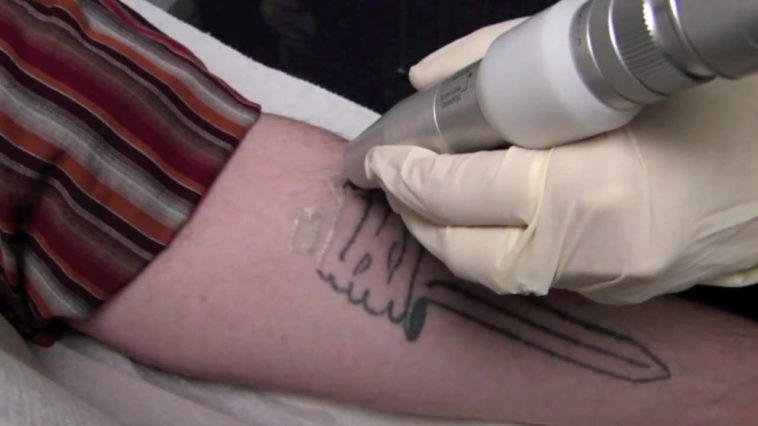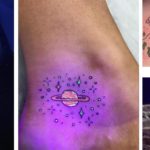From tattoo to tattoo removal
After passing under the needles, some people bitterly regret their tattoo, and they want to get rid of it because the tattooed pattern no longer corresponds to their desires.
In this article, we will see how it is possible to laser remove a body ornament inked with the advice of Dr. Hugues Cartier, dermatologist and former president of the Laser Group of the French Society of Dermatology.
To fall apart?
Before going to a tattoo artist, it is imperative to mature your tattoo project (do not hesitate to consult our Tattoopedia section to learn more about these different steps), but hey, with the passing years (sometimes too fast), the tattoo that we wear may no longer satisfy.
And that's when you're going to wonder how to erase it?
As a tattoo enthusiast, I'm going to tell you to think about getting a cover, but people are determined to remove their tattoo and we will discover how we can be tattooed with the laser.
Although there are plastic surgery techniques such as deep scrub that is very abrasive, they are now considered too heavy and obsolete because of the consequences of healing. Use is necessary if laser tattoo removal can not be considered.
What is tattoo removal?
Looking in the Larousse, without much surprise, we learn that tattooing is like destroying a tattoo. And to get rid of a tattoo (even if there is the good old technique of the sander that must be extremely painful and reserved for nags), nowadays, the laser is the most commonly used option.
(Embed) https://www.youtube.com/watch?v=W413eNqZfuE (/ embed)
There are different inks and these are composed of pigments that the action of the laser will "break" in order to be able to detach. The laser "breaks" somehow the tattoo ink balls under the skin, so that the body "digests" them.
But note that the more the tattoo is loaded with pigments, the more the number of sessions to remove it will be important.
Laser and tattoo
Tattoo removal is much more painful than being tattooed, roughly speaking, the action of the laser will be to "break" and destroy the pigments that are found in the ink. The sound the laser makes when it hits the skin to defragment pigments is pretty impressive and painfulDr. Cartier says it hurts a lot! It takes a local anesthetic. The first sessions can be painful and it happens that people abandon on the way tattoo removal. When the laser hits the tattoo, it can cause a burn, crusts, bubbles. Areas of the body such as the tibia, the back of the ear, the wrist or even the inside of the ankle are very painful when it is necessary to detach. You should know that a laser delivers a shock wave that equates to 100,000 watts, that's why we work on short times. "The dermatologist explains that when you go through the tattoo removal box, the location, the healing process (which is not the same depending on the areas of the body), the thickness of the tattoo, the use of colors (without talking about the composition of the pigments) are parameters that he must take into account. It is also very important to remember that tattoo removal is a time consuming process. "When a person is in a hurry, I refuse to unfasten it because it is a process that can sometimes take 3 years. The sessions are spaced because the skin is injured by the laser, there is inflammation. At first, you have to do a session every two months, then every four to six months. This allows for a normal slow healing – and thus leave as little trace as possible, ie a lightening of the skin at the site of the old tattoo. "
The colour
Yellow and orange are colors that are known to be difficult to remove by laser. According to an article published in Santemagazine.fr, blue and green are also reluctant to laser as to red or black, the action of the laser will be more effective. Note that mixtures to have a light color are difficult to make go! Dr. Cartier says that when a tattoo is composed of several colors (orange, yellow, purple), he may also refuse to thaw because he knows that it will not work. The practitioner also emphasizes the fact that it would be necessary to put in place a document making it possible to know the composition of the ink of the tattoo (the molecules used to pigment the skin are not always known), and when the molecule is struck by the laser causes a chemical reaction that turns it into a new molecule. Hugues Cartier notes that there is a soft focus at this level, and that not knowing the exact nature of ink pigments can represent a health risk – even if to date it is not possible to to say that tattooing and tattoo removal are bad for your health!
The so-called "amateur" tattoo, that is to say, made in the old fashion with Indian ink, is not difficult to remove because the ink is not affixed deeply under the skin, and it is much more "liquid", less concentrated than the tattoo ink overloaded with pigments.
Traumatic tattoos (stung too deeply and often by amateur tattoo artists), may require more laser sessions than a tattoo more extensive, thin and clear.
How many sessions?
Before going under the laser, it is necessary to ask your dermatologist for a quote to know how many sessions are necessary to remove the tattoo.
A tattoo removal session lasts 5 to 30 minutes and price start from 80 euros, but dermatologists do not necessarily apply the same rates and some sessions can go up to 300 euros or even more! The price will be, among others, determined by the quality of the laser used.
The size of the tattoo, the composition of the ink, the number of colors used, the location of the tattoo and whether it was stung by an amateur or a professional influential on the number of sessions.
Typically, tattoo removal may take longer than originally planned.
The sessions must be spaced several months, so it is imperative to be patient because to get rid of a tattoo, it takes more than a year or even three!
It is also important not to expose the laser treated body area to the sun, and to promote healing it is imperative to put a fatty substance or even to take antibiotics.
Do not scratch the crusts and do not swim in the sea or a pool!
Tattoos that can not be removed
There are also tattoos that are impossible to erase such as: tattoos based on lacquer, fluorescent ink, or even white ink. Tattoo removal works much better on light skin than on dark or dull skin where the effect of the laser is very limited and may cause depigmentation.
Where to go?
Dermatologists are the only ones who can use lasers because this is a medical procedure.



